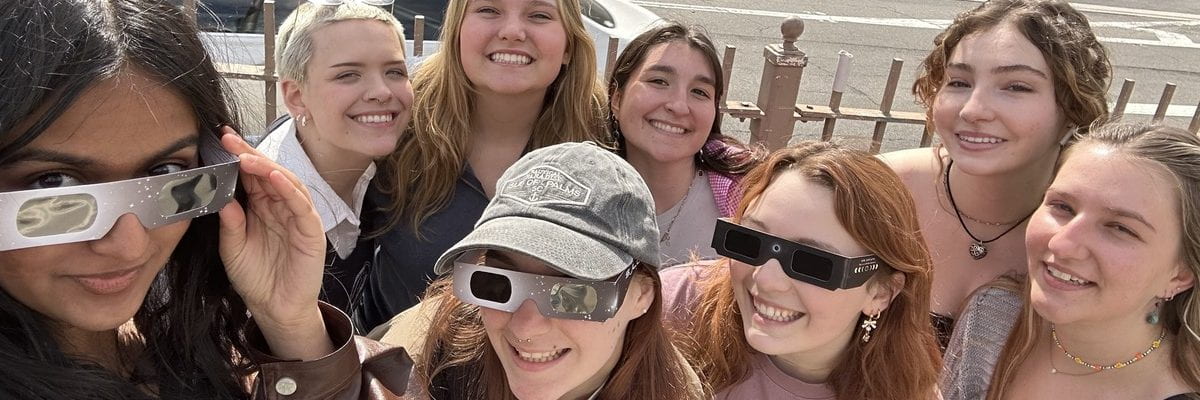On Monday, April 8, 2024, occurred perhaps the most shocking, exciting, nail-biting eclipse since the 2010 movie revealed that Bella was in love with both Edward and Jacob. Just like The Twilight Saga: Eclipse (2010), the “Great North American Solar Eclipse” was, for some, a once-in-a-lifetime experience, not only because the next total solar eclipse is not estimated to occur for the contiguous United States until August 23, 2044, but also because the recent eclipse was in many ways more fascinating and affecting than the eclipse that occurred in 2017. The path of totality was nearly twice the width of the 2017 eclipse, and it covered many more densely-populated areas, allowing many more people to see it than saw the 2017 eclipse; the number of residents along the path of totality increased from twelve- to thirty-one million, and millions more were able to travel to a spot along the path than were able in 2017. As well, totality lasted twice as long and the Sun was at its height of solar magnetic activity, producing visible bright pink prominences—unstable clouds of plasma suspended in space by the Sun’s magnetic force—making for a much more interesting eclipse, aesthetically and scientifically (NASA).
For Pace students and staff—if you weren’t lucky enough to be able to travel to the path of totality—at 3:25 p.m., we saw around 90% totality, which is still pretty awesome, if you ask me. It seemed like the whole city stopped for those ten-or-so minutes when everyone decided their work could wait and took the time to enjoy the beautiful weather and the equally-beautiful eclipse. There were pods of onlookers spread across FiDi, on the Brooklyn Bridge, in Battery Park, at Seaport. Special viewing events were held by the Empire State Building, One World Trade Center, The Edge, and the Top of the Rock at Rockefeller Center and various parks held free watch parties across the five boroughs (CBS News). The city-wide impact of the eclipse was perhaps felt the most frustratingly with the shortage of eclipse glasses, as those who procrastinated in procuring their own raced the streets, asking every third stranger, “Where did you buy your glasses? Are they sold out yet? Those were the last ones?” But the shortage just brought us onlookers closer together, physically and emotionally, as we generously shared the glasses (perhaps by taking turns, or even using them at the same time) with our friends and with complete strangers.
As NASA’s research has shown, a total solar eclipse is a huge event whenever it occurs, regardless of the levels of magnetic activity, the visibility of the corona (the outermost layer of the Sun’s atmosphere, or the ring which one sees around the moon during totality), or the amount of times Jacob takes his shirt off. Total solar eclipses have shown not only to impact people globally, but to affect the behaviors of animals around the planet as well: “Birds may return to their nests, thinking it’s nighttime, or nocturnal animals begin to wake up.…Total solar eclipses are a great reminder that humans are animals too.” There is a strange, almost eerie feeling that overwhelms us when we experience the stark change from light to dark, warm to cool, then back again—the same feeling that causes those abnormal animal behaviors. It’s a feeling that, even when viewing it in just partial totality, gives us all a sense of wonder, of childish glee as we gasp and cheer at the magic of the universe we live in.
The total solar eclipse of April 8, 2024, brought people together, not only in our own groups of friends at Pace, nor just in our FiDi community, tucked away in the little corner of Lower Manhattan, nor just across the United States; viewers from Ontario, Canada stood openmouthed at the sight, just as onlookers from Durango, Mexico did, and just as we did last Monday. If you haven’t had the chance to see a solar eclipse in full totality, sources say that it’s pretty cool—you should definitely try it before you miss that once-in-a-lifetime opportunity. On that note, as well, if you haven’t had the chance to watch The Twilight Saga: Eclipse (2010), don’t bother; the real eclipse is a much, much better viewing experience.
Some links to learn more about the April 8 eclipse:
The April 8 Total Solar Eclipse: Through the Eyes of NASA
How the 2024 Total Solar Eclipse Is Different than the 2017 Eclipse
